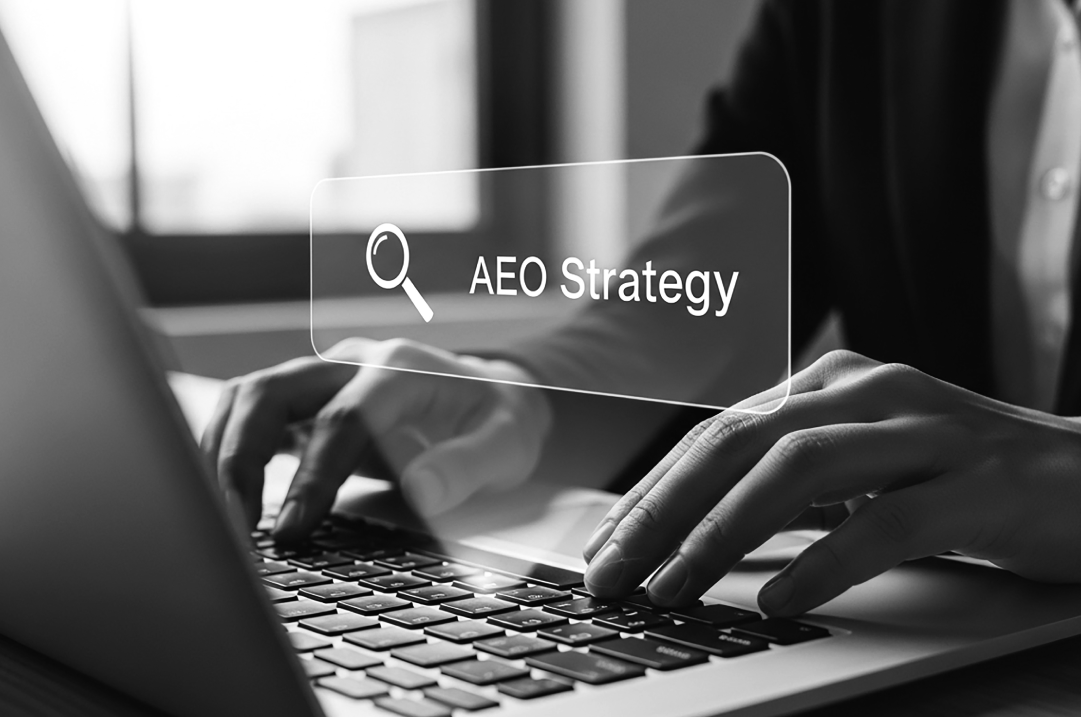Search is broken. Not the technology (that works fine). The problem? Most brands still optimize for yesterday's search behavior while their customers have moved on to AI-powered answers.
When someone asks ChatGPT about your industry or uses Google's AI Overview, does your brand show up as the trusted source? If you're not sure, you're already behind. Understanding the SEO vs AEO distinction is crucial for B2B brands staying visible in this evolving search landscape.
The shift from search to answers

Traditional search engine optimization (SEO) built its foundation on getting people to click through to your website. You'd craft content around keywords, build backlinks, and hope to rank on page one. The goal was simple: drive traffic.
Answer Engine Optimization (AEO) flips this model. Instead of optimizing for clicks, you optimize to become the definitive source that AI systems reference when they generate responses. Your content becomes the raw material for AI-powered answers across chatbots, voice assistants, and search engine overviews.
This isn't about replacing SEO. It's about evolving beyond it.
What is answer engine optimization (AEO)?
AEO is the practice of structuring content so AI-powered systems can easily extract, understand, and deliver your information as direct answers to user queries.
Where traditional search results show a list of blue links, answer engines provide immediate responses. Think ChatGPT explaining a complex concept, Google's AI Overview summarizing a topic, or Alexa answering a voice query. These systems don't just link to information. They synthesize it.
The goal is positioning your brand as the authoritative source these AI models cite. When someone asks about your industry, your expertise should be woven into the answer.
Key differences between SEO and AEO

Primary objectives
SEO focuses on rankings and clicks. Success means appearing high in search results and driving traffic to your website. You optimize for keywords, build authority through backlinks, and measure success through rankings and click-through rates.
AEO targets becoming the source of answers. Success means AI systems reference your content when generating responses, even if users never visit your site. You optimize for clarity, authority, and structured information that machines can parse and cite.
Content structure requirements
SEO content is comprehensive and keyword-rich. You create long-form articles that cover topics thoroughly, naturally incorporating target keywords throughout. The structure follows traditional blog formats with introductions, body sections, and conclusions.
AEO content is answer-first and conversational. You lead with clear, concise answers before providing supporting details. The focus on clarity and exceptional user experience has become essential across all digital platforms, as both human users and AI systems favor well-structured, accessible content. Headlines mirror natural questions people ask. Content uses structured formats like numbered lists, bullet points, and clear sections that AI can easily extract and reference.
Target platforms and user behavior
SEO targets traditional search engines where users browse multiple results, compare options, and click through to websites. The user journey involves research, evaluation, and eventual conversion on your site.
AEO serves AI-powered platforms where users expect immediate, authoritative answers. They interact with chatbots, voice assistants, and AI overviews that provide synthesized responses without requiring clicks. The value is delivered instantly, often without a website visit.
Query types and search intent
SEO handles varied query types from short keywords to longer phrases. It addresses informational searches ("content marketing"), navigational queries ("Brightscout contact"), and transactional intent ("B2B software solutions").
AEO optimizes for conversational, question-based queries that mirror natural language patterns. B2B buyers ask "What's the best way to optimize for voice search?" or "How does machine learning improve customer experience?" These queries seek specific, actionable answers.
Technical implementation strategies

Structured data and schema markup
Schema markup acts as a translator between your content and AI systems, serving as a foundational element of answer engine optimization. It helps machines understand what your content means, not just what it says.
Key schema types for AEO include FAQ markup for question-and-answer content, How-to schema for step-by-step guides, Article markup for blog posts and news content, Organization schema for company information, and Local Business markup for location-based services.
When implemented correctly, schema markup increases the likelihood that AI systems will extract and reference your content in their responses.
Content optimization techniques
Answer-first approach: Place the most important information upfront. If someone asks "What is AEO?", your first paragraph should contain a clear, complete definition before diving into details.
Natural language optimization: Write how people speak. Instead of optimizing for "AEO benefits," create content around "Why should companies care about answer engine optimization?"
Authority signals: Support answers with data, examples, and credible references. AI systems favor content that demonstrates expertise through specific examples, research citations, and clear sourcing.
Measuring AEO performance
Visibility metrics
Track your brand's presence in AI-generated answers through featured snippet monitoring, knowledge panel inclusion, voice search result tracking, and brand mention frequency in AI responses.
Tools like SEMrush and Ahrefs can help monitor featured snippet wins, while voice search analytics reveal how often your content appears in spoken results.
Engagement and business impact
AEO success extends beyond visibility to business outcomes. Monitor zero-click engagement rates to understand how many users find value in AI-generated answers that reference your content.
Track lead quality improvements, as users who engage with AI-referenced content often arrive more informed and closer to purchase decisions. Measure brand lift through surveys and attribution analysis to understand AEO's impact on awareness and consideration.
How AEO and SEO work together
AEO doesn't replace SEO. It amplifies it. While SEO drives traffic to your website, AEO positions your brand as the trusted source across AI-powered platforms.
The most effective SEO vs AEO approach combines both strategies. Use SEO to maintain strong organic visibility while implementing AEO to capture the growing share of zero-click searches and AI-mediated interactions.
Create content that serves both objectives: comprehensive enough to rank well in traditional search results, yet structured and authoritative enough for AI systems to extract and reference. This approach is critical as nearly 60% of Google searches now end without a click, making AEO essential for maintaining brand visibility. This holistic approach mirrors the principles of effective content strategy in digital product development, where content must serve both user needs and business goals.
5 steps for AEO adoption

1. Conduct an SEO and content audit
Review your existing content library and current keyword rankings. Identify pages that already perform well in search. These represent your best opportunities for AEO optimization since they demonstrate existing authority.
Look for content that could qualify for featured snippets, answer boxes, or knowledge panels. Audit your technical SEO foundation to ensure your site supports structured data implementation.
2. Implement schema markup
Add relevant schema types to your most important pages, starting with FAQ, How-to, Article, Organization, and Local Business markup based on your content type.
Use Google's Rich Results Test to validate your markup and ensure error-free implementation. Prioritize pages that already rank well, as they have the highest probability of earning enhanced search features.
3. Create question-focused content
Build new content around conversational, question-style queries that your audience asks. Research "what is," "how to," and "best way to" queries in your industry.
Structure answers clearly using headings, numbered lists, and bullet points. Include visuals, diagrams, or step-by-step instructions to improve your chances of featured snippet selection and voice search results. Consistency in content structure and formatting, much like principles found in well-designed systems, helps both users and AI systems understand and navigate your content more effectively.
4. Monitor and measure results
Track featured snippet wins, knowledge panel presence, and overall brand visibility in AI-generated responses on a monthly basis. This monitoring is crucial since over 70% of voice search results pull information from featured snippets, making snippet optimization essential for voice search visibility.
Monitor changes in traditional rankings and click-through rates to understand how AEO implementation affects overall performance. Use tools like Google Search Console, SEMrush, or Ahrefs to identify trends and opportunities.
5. Train your team
Educate writers, SEO specialists, and developers on schema markup implementation and why it matters for long-term visibility. For teams that need additional expertise, flexible development partnerships can provide the specialized skills needed to implement comprehensive AEO strategies effectively.
Create internal documentation and standardized processes for publishing AEO-optimized content. Include clear explanations of what is AEO and why it matters so your entire team understands the strategic importance of this optimization approach. Foster a culture of continuous optimization where team members actively look for opportunities to improve content structure and authority signals. This iterative approach to optimization mirrors the collaborative methodology of design sprints, where rapid testing and refinement lead to better outcomes.
The future belongs to answer-ready brands

Answer engine optimization represents the strategic evolution of search optimization. Industry analysts agree. Gartner predicts that by 2026, traditional search engine volume will drop 25%, with search marketing losing market share to AI-powered answer engines.
The shift is already happening. Google's AI Overviews now appear in more than 50% of all search results, marking a fundamental change in how information is discovered online. As AI-powered tools become the primary way people discover information, B2B brands that provide clear, authoritative, well-structured content will dominate the conversation.
The companies winning tomorrow won't just rank well in search results. They'll be the trusted sources that AI systems cite when answering questions about their industry.
The companies winning tomorrow won't just rank well in search results. They'll be the trusted sources that AI systems cite when answering questions about their industry.
Ready to position your brand as the definitive source in your space? Let's build an AEO strategy that makes your expertise impossible to ignore.
Brand + Website + SEO + AEO is a match and a fact to scale your B2B saas company.
Ready to position your brand as the definitive source in your space? Let's build an AEO strategy that makes your expertise impossible to ignore.


.png)




